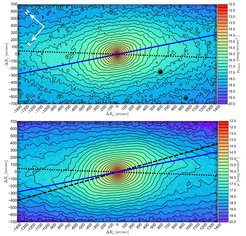Andromeda chained to the box - dynamical models for M31: bulge & bar
Blaña Díaz M., Wegg C., Gerhard O., Erwin P., Portail M., Opitsch M., Saglia R., Bender, R., 2017, MNRAS, 466, 4279

Andromeda is our nearest neighbouring disk galaxy and a prime target for detailed modelling of the evolutionary processes that shape galaxies. We analyse the nature of M31's triaxial bulge with an extensive set of N-body models, which include Box/Peanut (B/P) bulges as well as initial classical bulges (ICBs). Comparing with IRAC 3.6μm data, only one model matches simultaneously all the morphological properties of M31's bulge, and requires an ICB and a B/P bulge with 1/3 and 2/3 of the total bulge mass respectively. We find that our pure B/P bulge models do not show concentrations high enough to match the Sérsic index (n) and the effective radius of M31's bulge. Instead, the best model requires an ICB component with mass MICB = 1.1 x 1010 M⊙,and three-dimensional half-mass radius rhalfICB = 0.53 kpc (140 arcsec). The B/P bulge component has a mass of MB/P = 2.2 x 1010 M⊙ and a half-mass radius of rhalfB/P = 1.3 kpc (340 arcsec). The model's B/P bulge extends to rB/P = 3.2 kpc (840 arcsec) in the plane of the disk, as does M31's bulge. In this composite bulge model, the ICB component explains the velocity dispersion drop observed in the centre within R < 190 pc (50 arcsec), while the B/P bulge component reproduces the observed rapid rotation and the kinematic twist of the observed zero velocity line. This model's pattern speed is Ωp = 38 km s-1kpc-1, placing corotation at rcor = 5.8 kpc (1500 arcsec). The outer Lindblad resonance (OLR) is then at rOLR = 10.4 kpc, near the 10 kpc-ring of M31, suggesting that this structure may be related to the bar's OLR. By comparison with an earlier snapshot, we estimate that M31's thin bar extends to rbarthin ~ 4.0 kpc (1000 arcsec) in the disk plane, and in projection extends to Rbarthin ~ 2.3 kpc (600 arcsec).
